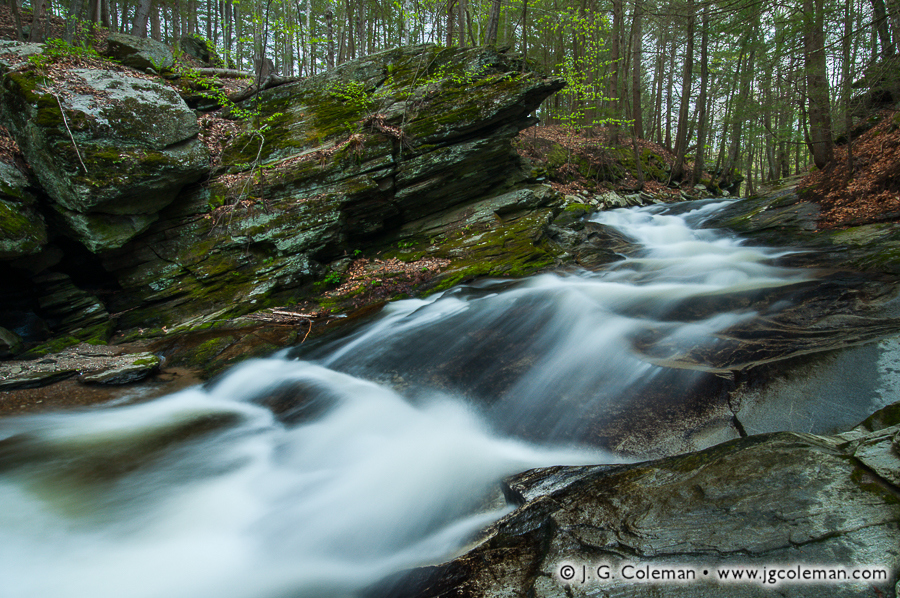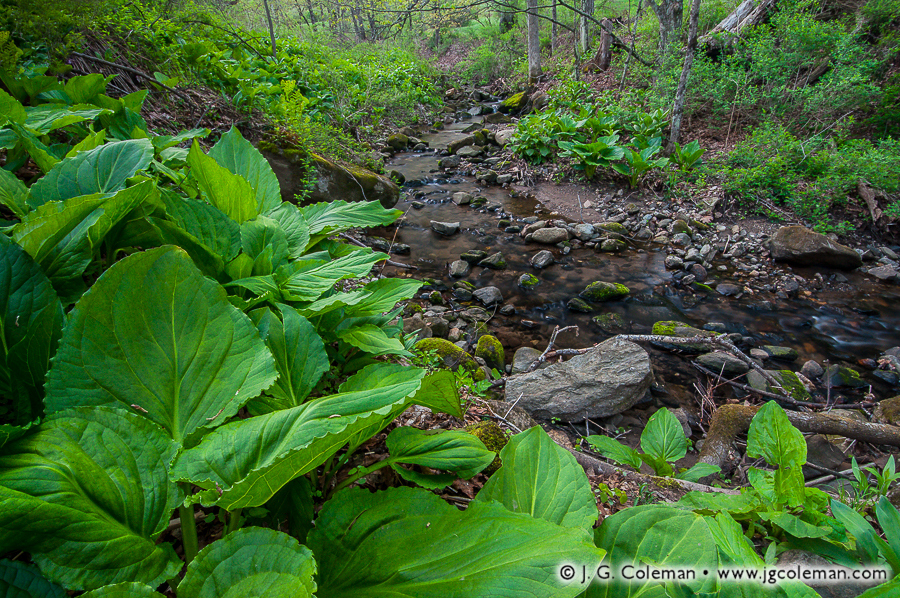
Jack’s Brook at Brian E. Tierney Preserve, Roxbury, Connecticut
© 2015 J. G. Coleman
My new release from the Brian E. Tierney Preserve, “Tierney Springtime”, brings you into the wooded hills of Roxbury in Western Connecticut. Jack’s Brook, a lively tributary of the Shepaug River, is found snaking through a rock-strewn glen in the faint morning twilight as broad, verdant leaves of riverside skunk cabbage jostle in the breeze.
Although the lush greenery of skunk cabbage is a refreshing sign of spring, anybody that has traipsed through patches of this plant in the wetlands as a child is all too familiar with the potent stench of its sap. That foul odor, not surprisingly, inspired the comparison to the rank odor unleashed by frightened skunks. Luckily, the stench of skunk cabbage isn’t quite as noxious and doesn’t linger nearly as long as that of an actual skunk, but it’s unpleasant just the same.
In spite of its unfortunate reputation, eastern skunk cabbage is actually a quite remarkable plant which is expertly adapted to the climatic extremes of New England. Beginning as early as January and February, the mottled flower hoods of skunk cabbage can be found melting through the snow and ice on their wetland habitat. That’s right: skunk cabbage is one of the rare plants that is able to generate it’s own heat, sometimes in excess of 20° to 30°F above that of the surrounding air. This incredible ability affords it the opportunity to push its flowers up in late winter in order to draw pollinating insects before its competitors have so much as sprouted. And believe it or not, even that offensive odor serves a very clever purpose. Since the smell roughly resembles that of rotting plants and animals, it attracts flies and similar insects that emerge very early in the year and pollinate the flowers of the skunk cabbage.

Jack’s Brook Cascades at Brian E. Tierney Preserve, Roxbury, Connecticut
© 2015 J. G. Coleman
But truth be told, finding this natural garden of springtime foliage was actually just a welcome bonus along the route to my planned destination. The sight that had drawn me out to Tierney Preserve to begin with was a waterfall locally known as The Cascades which was mentioned in Russell Dunn’s book, Connecticut Waterfalls: A Guide. He had opted to prepend that generic name with the name of the brook upon which the 15-foot falls are formed, thus making them Jack’s Brook Cascades. You can see this waterfall in my new piece, “The Falls at Tierney” (above), where they weave through a rocky, woodland gorge in the faint morning light filtering down through the springtime canopy.
From a purely technical perspective, the waterfall really is more of a steep, spirited cascade. But I can understand why Dunn included it in his waterfall guide, since Jack’s Brook Cascades are every bit a waterfall by aesthetic standards. That is to say, it simply feels like a waterfall. Suffice it to say, you can expect to see “The Falls at Tierney” added to my ever-growing Waterfalls of Connecticut collection, which I urge you to check out at connecticutfalls.com if you haven’t visited lately. I’ve added a few more waterfalls over the course of the past season, so you’ll probably find something new.
Purchase a Fine Art Print or Inquire About Licensing
Click here to visit my landing page for “Tierney Springtime” to buy a beautiful fine art print or inquire about licensing this image.
Want to See More?
Check out more of Connecticut’s exquisite waterfalls at my Waterfalls of Connecticut collection.

